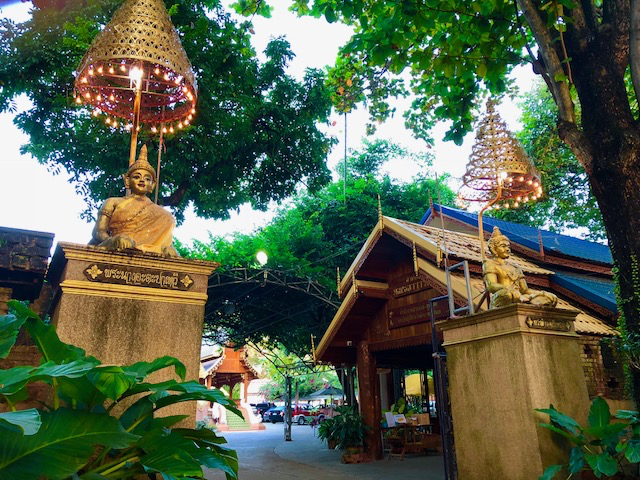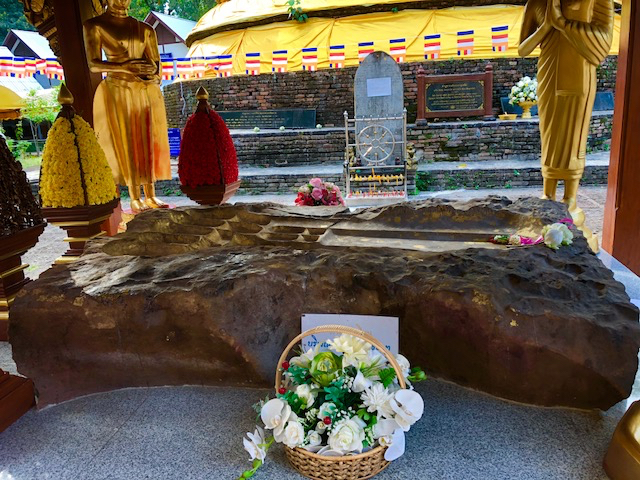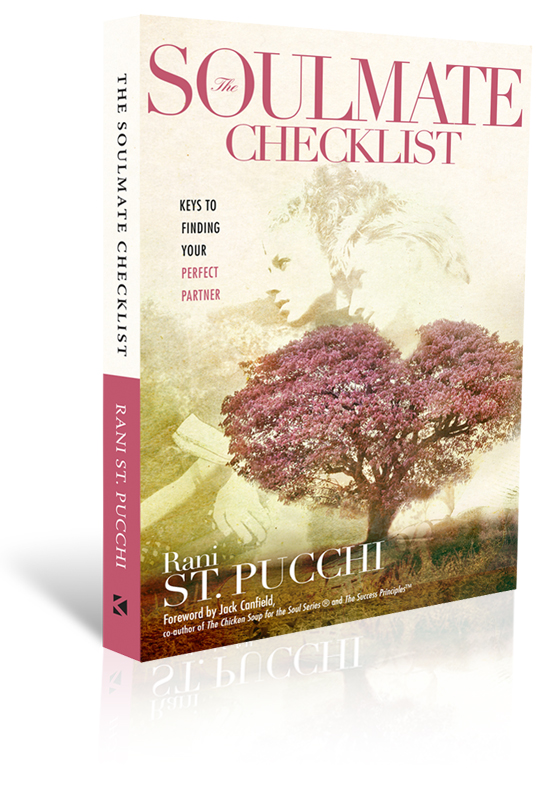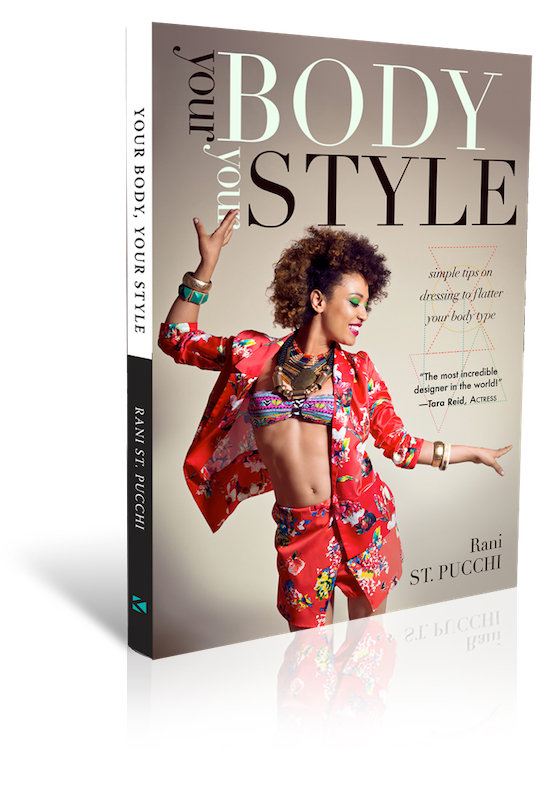Rarely is found in this world anyone
Who is restrained by shame and wide-awake,
As a thoroughbred horse avoids the whip
Thoroughly worn out is this body,
A net of diseases and very frail
This heap of corruption break to pieces,
For life indeed ends in death.
~The Buddha’s Words in The Dhammapada
Vipassana is taught in various different methods and traditions. The style of Vipassana taught at Wat Ram Poeng is based on the teaching methods of the 20th century Burmese monk Mahasi Sayadaw using alternating periods of sitting and walking meditation.
Traditional white clothing is mandatory for all meditators practicing Vipassana at the temple. The course takes 26 days to complete and the minimum requirement is ten days.
Meditation at the temple generally follows a cycle of kraap (bowing), walking, and sitting. The instructions start very simple and then build. In the beginning we are told to alternate sitting and walking meditation for short periods of just 15 to 20 minutes each. During the walking meditation we are taught to focus our attention on a single point of reference, and as we advance, to alternate between different points of reference in the body and the breath.
By day ten of my stay, the last day, I had completely surrendered to the experience and realized by doing so that I was able to effortlessly master seated meditation for an hour at a stretch, and walking meditation up to two hours at a time.
I must admit it wasn’t easy though. At first I was like a child learning to walk. The thought of meditating and finding peace was exciting, but once I started practicing it quickly turned frustrating, embarrassing, and even painful -especially the seated part. I fidgeted a whole lot. My knees hurt, my back, hips, chest, knees, ankles and thighs hurt, and my feet would go numb on me. I alternated between sitting on a meditation mat on the floor to sitting up on a low chair with my back resting against a wall, to meditating on my bed (which was never a good idea because then I would doze off!). But I was determined to fulfill the expectations and the hours assigned to me every day, which grew longer and more intense as the days wore on.
The present moment is immensely important to meditation practice. Because it is only when one acknowledges the present moment can one develop and strengthen momentary body/mind concentration. Being mindful from the moment we are awake to the moment we fall asleep, to acknowledge with continuity our daily activities, these help keep the mind from wandering away and getting distracted.
Lord Buddha gave five purposes for insight meditation:
To purify the mind
To get rid of sorrows and lamentations
To get rid of physical and mental sufferings
To understand the truth of life
To extinguish suffering and gain Nibbana (Nirvana)
I chose to do my walking meditation around the sacred stupa which dates back to the founding of the temple in 1492. I would light incense and take three rounds and recite this mantra:
Namo Tassa Bhagavato Arahato SammaSambuddhasa
(Homage to the Blessed One, the Noble One, the Perfectly Enlightened One)
As I practiced Vipassana, all sorts of thoughts drifted through my mind — a few were pleasant, but most not so. In fact some were absolutely terrifying. My life flashed before my mind’s eye. I had the most vivid memories of my early childhood, then my school years at the Catholic convent, then the time I was forced into an arranged marriage and all the abuse that ensued, and on and on… It was hard to not get emotionally charged as I relived my life. It dawned on me that throughout my life I had been running away from those who would tame me — running toward freedom, to be able to breathe, to think for myself, to make my own decisions, even make my own mistakes.
And as I relived my life I asked myself “Am I really free?”
Strange that so many of us go through life looking for permission, for validation. We place a self-made cage around ourselves even though the door is wide open and we hold the key. We never allow ourselves, never think we deserve, never believe we are worthy.
This reminded me of the story about the baby elephant that is tied by a small rope at a very young age by its trainer — a rope that is strong enough to hold it at that small age. As the elephant grows older it is conditioned to believe that it can never break away, so it remains tied by the same thin rope. There are no chains, no cages. It is obvious to anyone looking at the elephant that it could at any time, with a mere gentle tug, break away from the rope it is tied to. But for some reason it does not. The beautiful, strong and magnificent animal just stands there and makes no attempt to break away because it does not believe it can.
Just like the elephant, how many of us go through life living in a prison of our own making, hanging on to the limiting belief that we cannot do something, anything, simply because we had been held back for so long by old, outdated beliefs that were imposed on us by others? How many still continue living a life imprisoned by other people’s expectations of us, by a society that would continue to judge us wrong even though we have done everything right? How many of us continue to hope for acceptance, for validation from our elders, even from our children and loved ones, all the while knowing perfectly that it will never come, but still we wait and wait…
Believe me when I say that this was by far one of the most traumatic, yet enlightening journeys of my life. I had not shed so many tears for a very long time as I did during those ten days. I experienced many revelations and epiphanies. I mourned. I mourned the loss of my dear ones, the loss of my childhood, the loss of so many opportunities that were handed to me but were rejected because I didn’t feel I deserved. I was expected to be brave, to be strong, to be the breadwinner and take care of everyone. Even when they betrayed me. I had no choice ever, but to put on a brave front, an ‘all is perfect in my world’ attitude, not asking, not allowing, never receiving. Always the giver, I gave and then gave some more. Because, of course, it is noble to give- is it not?
Yes, I was a mess. But after the first few days at the monastery my mind started to feel wonderful and free; the world started to appear so much simpler.
But would it last?
I had so many questions for the Abbot…
To be continued…
© Rani St. Pucchi, 2018
Rani St. Pucchi is an award-winning Couture Fashion Designer, a Style & Image Consultant, and a Relationship Expert. She is a Bestselling Author, a Speaker, an Inspirational Coach and a Trainer. Her recent TEDx talk: Is Your Body Image Holding You Back has received worldwide acclaim. Rani’s #1 International Bestselling Books, Your Body, Your Style: Simple Tips on Dressing to Flatter Your Body Type ; The SoulMate Checklist: Keys to Finding Your Perfect Partner; and Your Bridal Style: Everything You Need to Know to Design the Wedding of Your Dreams are available on Amazon and at Barnes & Nobles.
For more information on Rani please visit www.ranistpucchi.com





 Rani St. Pucchi is an inspirational speaker, empowerment coach, bestselling author, image consultant, and founder and designer of St. Pucchi, the internationally acclaimed bridal fashion house. She draws on her more than 30 years in the fashion industry to help women abandon debilitating self-doubt, and become the designers of their own lives. Rani empowers thousands of women across the world with her message of body-positivity and self-love.
Rani St. Pucchi is an inspirational speaker, empowerment coach, bestselling author, image consultant, and founder and designer of St. Pucchi, the internationally acclaimed bridal fashion house. She draws on her more than 30 years in the fashion industry to help women abandon debilitating self-doubt, and become the designers of their own lives. Rani empowers thousands of women across the world with her message of body-positivity and self-love. 


